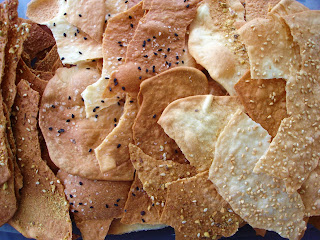Woo-hoo!
I am thrilled to be a part of this group of Daring Bakers! Allow me to elaborate: every month, the Daring are given a challenge (in secret) of the baking sort. It could be savory, it could be sweet. There's a place where everyone can meet and trade secrets or horror stories. And then, all at once, we tell the world all about it. (This is my first one, can you tell?)

In the short time I've been a part of this group, I have only emailed the founding members (Lis and Ivonne), I dunno, too many times to count, so I would like to thank them for their time, as I can't imagine what else they
would have time for. If you are interested in learning more, details abound at the
Daring Baker's Blogroll.
I'm so enamored with the whole thing, in fact, that I've written
all about it. If you care to read on, I must say I appreciate your tenacity. If you just want to make this cake, check out
Cream Puffs in Venice.

Now, back to the nitty gritty. Opera Cake. And light Opera Cake, at that (light flavors and colors, no dark chocolate here). I was a little taken aback by the first challenge I'm getting my hands on, here. Buttercream, almond sponge, not easy stuff.
I had lofty aspirations, I was getting all carried away with my ingredients. I would buy almond meal (not make it), only the best butter (for the buttercream), and nothing but pure white chocolate would do (for the glaze). Then I went shopping. I'll make the almond meal (no time to run all over town), the butter I normally use is just fine (no need to be fussy), and white baking chips are a reasonable substitute (white chocolate is
how much per pound?).
Once I got over that part, I needed equipment. Any excuse to go to the restaurant supply store is a good one; my answer to the kid in a candy store. Seriously, I could spend all day there. And no, I don't really need a Robot Coupe (ultra-duty food processor), a Vita-Prep (ultra-duty blender), or a portable nacho cheese cart. But, I do need a 1/2 sheet pan, a cake spreader, and some pastry tips (you never know when you might need a pastry tip).
First, I went with the buttercream. (Oh yeah, the flavor of my cake will be lemon.) So, there was some mention in the recipe about the sugar temperature being too high (a buttercream consists of a meringue, which is eggs beaten with a heated sugar syrup, then plenty o' butter beaten into the meringue), but I didn't let that stop me. I made the buttercream, no problem. It was actually quite easy. "What's all the fuss about?" I wondered. But it didn't make very much; and then my eye caught the singled-out egg yolk that didn't find its way in there (which is maybe why it didn't make so much). Drats.

Then I made buttercream again, and again, and again. Yes, my second and third time were complete failures. And the third time, I did
exactly what I did the second time (overheated the sugar syrup). Nope, didn't learn anything that last time, apparently. Oh wait, now I get it,
it's not that easy, quit being a show-off (yes, inner dialogue). So the fourth time went okay. And it was better than the first. The end result, luscious lemon buttercream so good I ate it by the spoonful. Good thing I
made more.

Then came the
joconde. Fancy name, no? It is essentially an almond sponge cake, wherein the almonds take place of most of the flour. Because this cake depends on egg whites to do the leavening, and fat deflates egg whites (which almonds have plenty of) this is a challenging cake. Everything must be ready to go, ingredients combined quickly, and into the oven before the cake has time to settle into the pan. Phew.
Mine did come out a bit lopsided, but I was happy with it overall. After cooling, it was time to assemble. This is the dreadful part, for me, anyway. I sat there staring at each piece of the puzzle, hoping I would like it just the same when it was all put together.

For three layers of cake, the first was brushed with a lemon syrup (simply sugar, a touch of water, and fresh lemon juice in at the end), reminiscent of lemonade itself. I skimped a bit, not sure if I really wanted a lemonade cake, but in the end, I should've been more generous (note to self). Then a layer of buttercream. Buttercream is
not easy to spread, people! Seriously, when did this happen; it's icing for goodness sake. It's just cake and icing. Hah!
Another layer of cake, some syrup, more buttercream, repeat. Okay. Now the glaze part. The glaze was essentially a white chocolate ganache (white chocolate with enough cream added to keep the chocolate soft after setting). Well, as I said, I had white baking chips, more of a white chocolate substitute, you could say. Actually, I have to give this one the thumbs up, the coco-nutty notes (hello, palm oil) really complemented the intense lemon flavors in the cake.
Warm = fluid. This is how ganache works. Now put that on butter. Hmm. So, yes, I chilled the cake, I waited as long as I could to let the glaze cool, and most of it ended up on my kitchen counter. Good thing, 'cause it would have been too thick otherwise. Charmed life, eh? I usually realize this after the panic.

I brought the finished cake to work, couldn't bare to let it win multiple staring contests at home. One of my colleagues had a piece for breakfast. Probably the greatest compliment I've ever had.
Me eating it for breakfast doesn't count.
















































